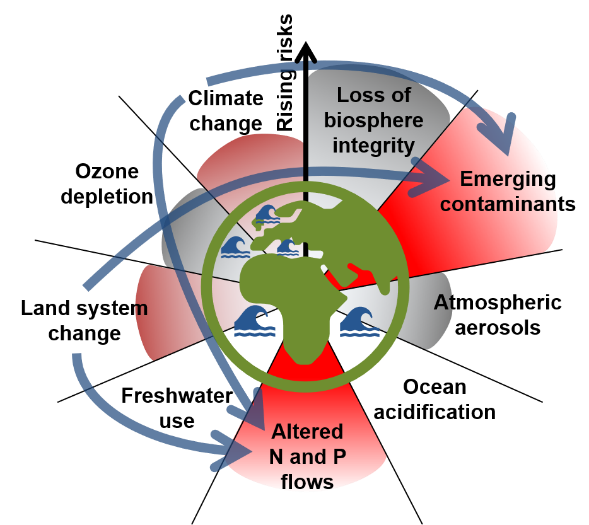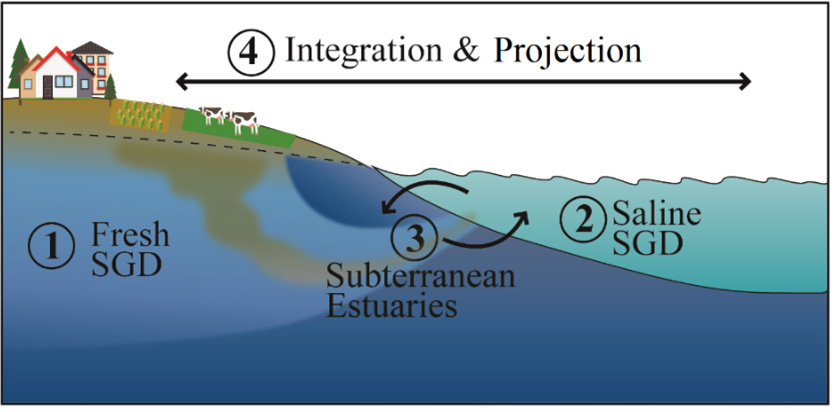Unravelling the legacy of historical, emerging, and future groundwater pollution to the ocean (LEGACY)
Most European countries have long-term legacy groundwater pollution and experience recurrent coastal water quality issues that may be a result of submarine groundwater discharge (SGD). Groundwater flows occur on time scales of decades, are essentially invisible, and difficult to quantify. SGD is the least understood water pathway, but can play a major role driving water quality in the coastal ocean. However, pollutant budgets often overlook SGD due to the interdisciplinary nature of the problem and/or lack of data at appropriate scales. Today’s sources of old, emerging and new pollutants include numerous pharmaceuticals used for human and animal health as well as conventional heavy metals and nutrients (nitrogen and phosphorus). Both emerging and conventional pollutants have exceeded Earth’s planetary boundaries, representing major threats to our long term survival. This project will reveal whether coastal groundwater, which started being polluted decades ago, has been seeping out along shorelines, and is driving water quality issues in the coastal ocean at a Pan-European scale. We will quantify continental-scale pollutant transport via SGD into all European marginal seas; resolve its driving forces at the continental-scale using oceanographic cruises and radium isotopes; assess whether subterranean estuaries attenuate legacy contaminant transport, and predict how climate change and land use intensification will alter these processes. This project will bridge disciplines to challenge common assumptions about the sources of chemical pollution to coastal waters using an innovative combination of novel tracer techniques, advanced modelling, and laboratory investigations. The outcomes of this project will be important for developing large-scale pollutant and nutrient budgets and models, which are required for the creation of effective management solutions in iconic European coastal waterways experiencing persistent, unresolved water quality issues.

Project description
European seas are some of the most impacted on Earth due to large populations, historical terrestrial sources, and slow flushing. For example, the Baltic remains as the most impacted sea on Earth, while the Mediterranean is highly sensitive to pollution due to low nutrient conditions. Established, emerging and new pollutants include numerous pharmaceuticals used for human and animal health as well as better known heavy metals and nutrients (nitrogen and phosphorus). Both emerging and conventional pollutants have exceeded Earth’s planetary boundaries, representing major threats to our long term survival.
Increasing incidences of groundwater and coastal water pollution threaten humans and global ecosystem health. However, water quality management investments worldwide have been short-sighted and led to minimal improvements. Such failures are in part due to pollutant releases from legacy sources accumulated in groundwater. The scale of management actions (years, catchments) has not matched the scale of the growing groundwater source (decades, continents).
Groundwater flows over long time scales, are essentially invisible, and difficult to quantify. Submarine groundwater discharge (SGD) is the least understood water pathway, but plays a major role driving water quality in the coastal ocean. Most European countries have long-term legacy groundwater pollution and experience recurrent coastal water quality problems that may be a result of SGD. However, pollutant budgets often overlook SGD due to the interdisciplinary nature of the problem and lack of data at appropriate scales.
This project will resolve whether coastal groundwater, which started being polluted decades ago, has been seeping out along shorelines, and is driving water quality in the coastal ocean at a Pan-European scale. We will reveal where and how SGD acts as a large-scale source of pollution, consider the time scale of the processes and project long term change of future legacies. This project will bridge disciplines to challenge common assumptions about the sources of chemical pollution to coastal waters using an innovative combination of novel tracer techniques, advanced modelling, and laboratory investigations.
The outcomes of this project include resolving an unquantified pathway of pollution, testing the effectiveness of an interdisciplinary approach, and supporting better management and water quality legislation. Without an understanding of all pollution sources and pathways, and the attenuation processes occurring in coastal aquifers, realistic models cannot be conceptually or quantitatively developed. This project will inform sustainable development goals by developing large-scale pollutant budgets that are essential to for the creation of effective management solutions in iconic European coastal waterways experiencing persistent, unresolved water quality issues.
As groundwater is better understood, it will be possible to detect changes in these pathways due to disturbances, such as land-use change, clearing of habitats, and climate change. The new scientific knowledge generate here has the potential to revolutionize our approach to global water quality management by accounting for a source that has been hiding in plain sight.

